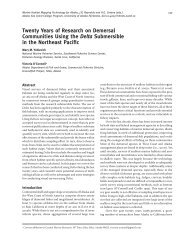724_Final Report.pdf - North Pacific Research Board
724_Final Report.pdf - North Pacific Research Board
724_Final Report.pdf - North Pacific Research Board
Create successful ePaper yourself
Turn your PDF publications into a flip-book with our unique Google optimized e-Paper software.
observed in CCs (e.g., Nordstrom et al. 2008). Twenty-seven subsets of the 72 FAs identified were tested<br />
in our model optimization exercise (see Appendix 1). Relative proportions of individual FA in each new<br />
subset were normalized to a sum of 100%. Subsets were used in the QFASA model and performance was<br />
evaluated using all biopsies and all diets from all eiders. The FA subset that provided the lowest overall<br />
sum of the squared errors (SSE) of diet was determined to be the optimal subset for our QFASA model,<br />
where SSE = (actual proportion of diet item – model estimate of diet item) 2 summed across all diet items<br />
for Diet 1, 2, and 3.<br />
QFASA model<br />
To evaluate the reliability with which diet items could be distinguished in the model, we first performed a<br />
number of simulations using the captive eider diet database. These simulations were performed without<br />
CCs to assess the ability to estimate diet composition based only on differentiating and quantifying diet<br />
items by their FA signatures (sensu Iverson et al. 2004). We constructed five pseudo diets: Diets 1-3 were<br />
based on the actual Diets 1-3 that the eiders consumed. Diet 4 represented a marine diet without the<br />
commercially processed Mazuri. Diet 5 represented a diet comprised of only bivalves, which are the<br />
primary diet item for spectacled eiders wintering in the Bering Sea (Lovvorn et al. 2003). Simulations<br />
were used to evaluate how the accuracy of our estimates was affected by diets and FA subsets.<br />
Simulations were performed 1000 times for each constructed diet. Prey-on-prey simulations were also<br />
performed to determine how well each individual diet item could be differentiated as itself from all other<br />
diet items in the diet library. These were done by taking each diet item in the library and dividing the<br />
samples into two sets: a modeling set and a simulation set. The selected diet item was modeled with the<br />
modeling set and all other diet items in the prey library. The simulation was performed 1000 times for<br />
each diet item. Details of the simulation procedures are provided in Appendix B in Iverson et al. (2004).<br />
15



